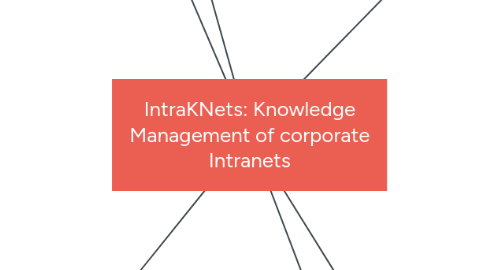
1. Concepts
1.1. Knowledge
1.1.1. Information resident in people’s minds, which is used for making decisions in unknown contexts
1.1.2. In order to have value, knowledge must be applied to a new situation on which a decision or action can be made
1.1.3. Two forms
1.1.3.1. Explicit knowledge is easily codified and conveyed to others.
1.1.3.2. Tacit knowledge is experiential, subjective and personal, and substantially more difficult to convey.
1.2. Knowledge Management
1.2.1. KM is a tool set for the automation of deductive or inherent relationships between information objects, corporate users and business processes
1.2.1.1. Information objects
1.2.1.2. Corporate users
1.2.1.3. Business processes
2. Discussion
2.1. Information vs Knowledge
2.1.1. It is important to notice the distinction between knowledge and information. These two are distinct entities. While 'information' stored in a computer system is not a very rich carrier of human interpretation for potential action, ‘knowledge’ resides in the user’s subjective context of action based on that information.
3. Path to success with KM
3.1. Pre-requisites
3.1.1. Clear idea of the features and functionality of KM products.
3.1.2. Awareness of the business goals and the critical success factors to implement and roll out a KM program
3.1.3. A thorough understanding of the role of technology in the implementation of a KM program.
3.2. To start
3.2.1. Identify the purpose of the KM program
3.2.2. Have top management support
3.2.3. Be at the core of medium to long term business goals.
3.2.4. Break the cycle of information hoarding (intentional and non intentional).
3.2.4.1. Information hoarding is sometimes the result of lack of tools to share the information.
3.2.4.2. Hoarding is the result of non-realization that the information could actually be important to someone in another part of the organization.
3.2.4.3. Organization needs to prove to "knowledge holders" that they will benefit themselves from sharing information.
3.2.5. Insure growth and flexibility — by providing the ability to customize and adjust the product over time.
3.2.6. Manage the user base, by taking into consideration both heavy and light users.
3.2.7. Make sure that technology role is that of a facilitator and not a replacement for human expertise and intelligence.
3.3. About technlogy and systems
3.3.1. Scalable
3.3.2. Extensible
3.3.3. Compliant with industry standards, allowing companies to leverage existing resources
3.3.4. Secure
3.3.5. Relevant and Timely
3.3.6. Collaborative
3.3.7. Powerful off-line analysis
3.3.8. Allow for complex queries
3.3.9. Fast and easy to administer and deploy
3.3.10. Flexible
3.3.11. Heuristic
3.3.12. Suggestive
4. Knowledge Management Solutions features
4.1. Main functions
4.1.1. Information acquisition
4.1.2. Information Discovery
4.1.3. Information Publishing
4.1.4. Information Distribution
4.2. Common Features
4.2.1. Indexing
4.2.2. Knowledge Submission
4.2.3. Knowledge Retrieval
4.2.4. Knowledge Repository
4.2.5. Content Management
4.2.6. Administration Tools
4.3. Function categories
4.3.1. Intermediation
4.3.1.1. Brokering or knowledge transfer between an appropriate knowledge provider and knowledge seeker.
4.3.1.2. "Match" a knowledge seeker with the optimal source of knowledge for that seeker.
4.3.1.3. Ensures a much more efficient transfer of knowledge.
4.3.2. Externalization
4.3.2.1. Transfer of knowledge from the minds of its holders into an external repository, in the most efficient way possible.
4.3.2.2. The function of externalization is to provide the sharing of knowledge.
4.3.2.3. Through KM tools it is possible to track the vast quantity of data about competitors — from news stories to price changes.
4.3.3. Internalization
4.3.3.1. Extraction of knowledge from the external repository, and the filtering of this knowledge to provide greater relevance to the knowledge seeker.
4.3.3.2. Knowledge should be presented to the user in the form most suitable to its comprehension.
4.3.3.3. May include interpretation and/or reformatting of the presentation of the knowledge.
4.3.3.4. Companies can build yellow pages thus mapping and categorizing the skills and work experience of the organization.
4.3.3.5. Documentation of best practices.
4.3.4. Cognition
4.3.4.1. Function to make decisions based on available knowledge.
4.3.4.2. Cognition is the application of knowledge which has been exchanged through the preceding three functions.
4.3.5. Measurement
4.3.5.1. All KM activities that measure, map and quantify corporate knowledge and the performance of KM solutions.
4.3.5.2. Acts to support the other four functions, rather than to actually manage the knowledge itself.
5. KM Goals
5.1. To Capture Knowledge
5.1.1. This goal can be achieved by creating KM repositories. Those will consist of structured documents with Knowledge embedded in them — memos, reports, presentations, articles — stored in a way that they may be easily retrieved.
5.2. To Improve Knowledge Access
5.2.1. To facilitate the processes of knowledge transfer between individuals and between organizations.
5.3. To Enhance the Knowledge Environment
5.3.1. Proactively facilitating and rewarding knowledge creation, transfer and use.
5.4. To Manage Knowledge as an Asset
5.4.1. Some companies are including their intellectual capital in the balance sheet, others are leveraging their knowledge assets to generate new income from or to reduce costs with their patent base.
